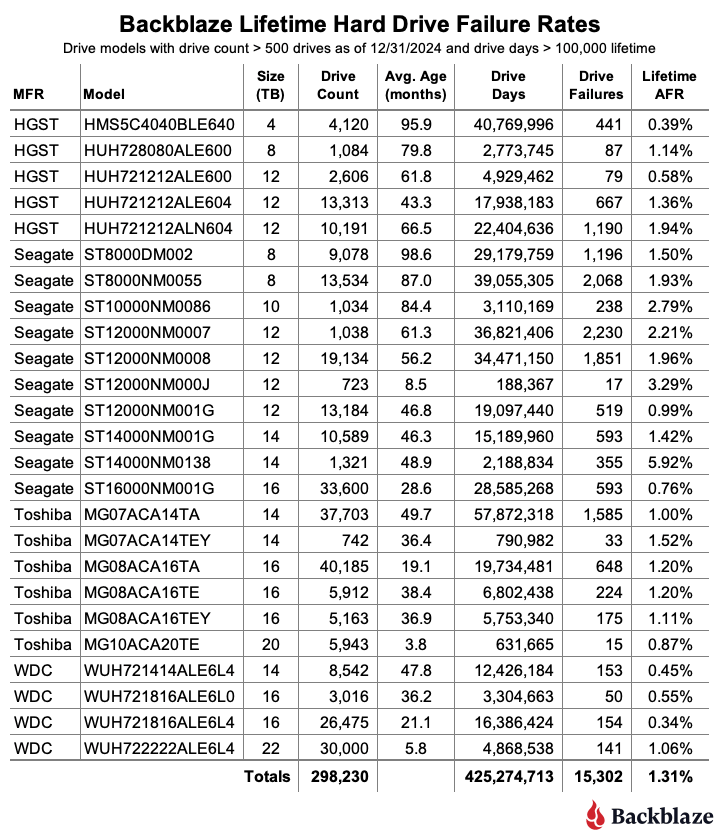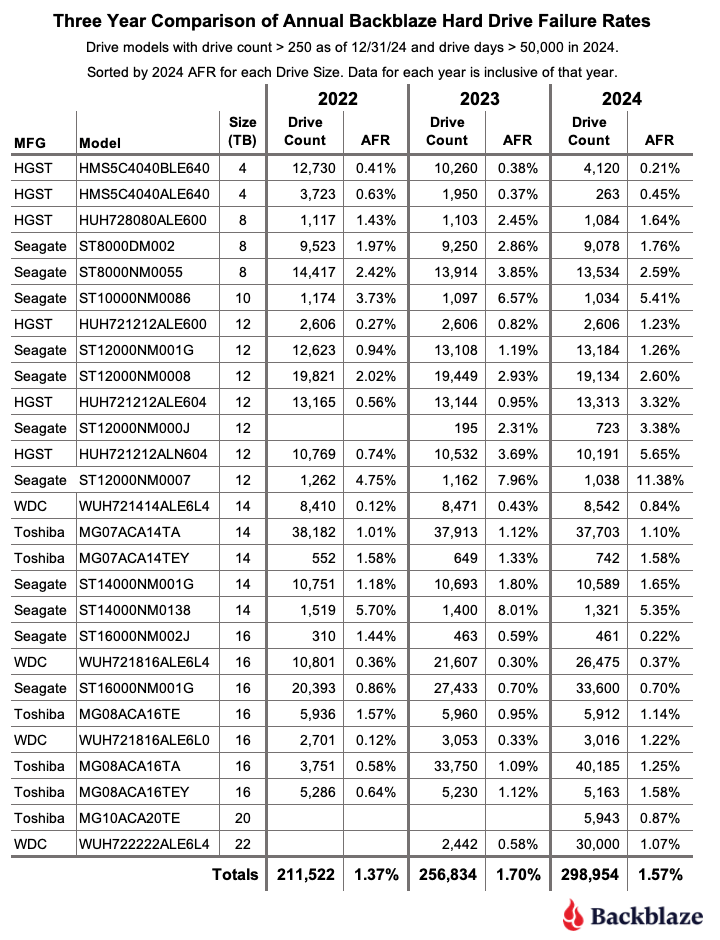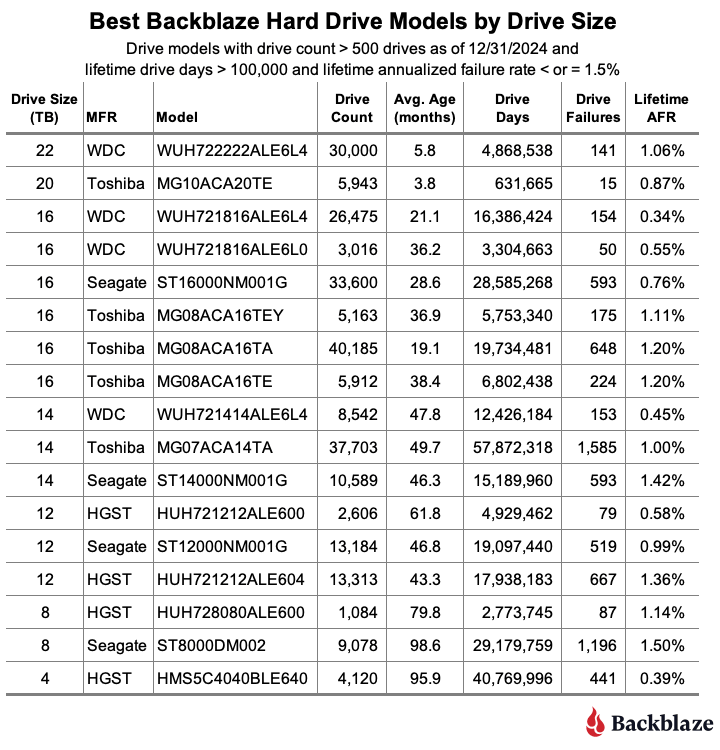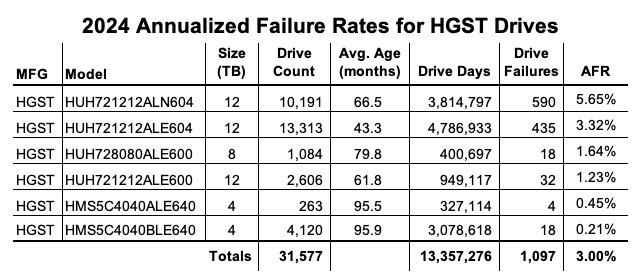Backblaze has released its 2024 Drive Stats Report, providing a detailed look at the failure rates of over 301,000 data drives in its storage infrastructure. As one of the most widely regarded independent sources for hard drive reliability data, this report offers insights into annual, quarterly, and lifetime failure rates, helping businesses and individuals make informed storage decisions.


Q4 2024: Hard Drive Failure Rates and Emerging Trends
At the end of 2024, Backblaze was actively monitoring 301,120 data drives, though 487 were excluded from the Q4 analysis due to insufficient data points. This left a dataset of 300,633 drives, which helped give a valid quarter-by-quarter comparison. The annualized failure rate (AFR) for Q4 was 1.35%, a noticeable drop from 1.89% in Q3, mainly due to the introduction of newer, high-capacity drives.
One of the most significant developments was the December arrival of Seagate’s 24TB hard drives (model ST24000NM002H). These drives filled an entire Backblaze vault, and none had failed as of the end of Q4. While it’s too early to determine their long-term reliability, early indicators suggest that larger-capacity drives perform well.
Several other models also completed Q4 without a single failure, including a 4TB HGST model, an 8TB Seagate drive, a 14TB Seagate model, and a 16TB Seagate unit. However, since these drives had relatively low usage numbers, their zero-failure status should be cautiously viewed.
On the other end of the spectrum, Backblaze continues to phase out its use of 4TB drives, with the fleet decreasing by another 1,774 units in Q4 2024. The remaining 4,000 drives are expected to be fully retired by Q1 2025, making way for the 20TB, 22TB, and 24TB models that now dominate the storage landscape. Despite their age, these 4TB drives still showed solid reliability, with just a single failure recorded in Q4.
Annual Failure Rates for 2024: Lower Than 2023, but Variations Persist
Backblaze tracked 298,954 drives for the entire year, with an overall AFR of 1.57%, slightly improving from 1.70% in 2023. The data suggests a shift in failure trends, primarily influenced by the deployment of higher-capacity drives and the continued aging of mid-sized models.
Among the more striking findings was that no drive model had a zero-failure year, though Seagate’s 16TB ST16000NM002J drive came close, recording just a single failure in Q3 and maintaining an AFR of 0.22% for the year. Meanwhile, 8TB and 12TB drives showed higher failure rates, consistent with the expected aging patterns of drives that have been in service for over five years.

Backblaze’s data center teams were busy throughout the year, installing 53,337 new drives in 2024. To put that into perspective, an average of 26 drives were installed every working hour. These installations primarily focused on replacing older, lower-capacity drives with newer models, contributing to the overall reduction in failure rates.
Although the 24TB Seagate drives debuted in 2024, they weren’t included in the annual AFR data due to late deployment. However, early Q4 numbers suggest they could be key in reducing failure rates in 2025.
Trends Over the Last Three Years: What’s Changing in Hard Drive Reliability?
The long-term trends show a gradual decrease in overall failure rates across 2022, 2023, and 2024, despite some fluctuations among specific models. Older 8TB and 12TB drives have started to see increased failure rates, a pattern expected as drives approach their fifth year or beyond in service.
At the same time, 14TB and 16TB drives (which comprise 57% of Backblaze’s total drive fleet) are currently in the most stable phase of their lifespan. These models generally maintained low and predictable failure rates, reinforcing the expectation that drives between two and four years old perform the most reliably.

The impact of new 20TB, 22TB, and 24TB drives on overall AFR is just beginning to show. Since these models are still in the early stages of their operational life, their failure rates are expected to remain low in the short term before settling into predictable long-term patterns.
Manufacturer Breakdown: Who’s Performing Best?
Looking at failure rates by manufacturer gives a pretty interesting look at which brands are holding up over time and which ones might be struggling. For example, HGST drives showed an uptick in failures in 2024. This shift was driven primarily by two specific 12TB models, which exhibited significantly higher AFRs than others in the lineup:
- The HUH721212ALN604 had a 5.65% AFR in 2024, making it one of the highest failure drives in Backblaze’s dataset.
- The HUH721212ALE604 had a 3.32% AFR, significantly higher than other HGST models.
Without these models, the HGST failure rate would have been just 0.55%.

Seagate, however, demonstrated a slight but consistent decrease in failure rates from 2022 to 2024. This trend was influenced by the removal of aging 4TB drives, and newer Seagate models, particularly those in the 16TB and 20TB range, have performed reliably.
Toshiba’s failure rates remained stable, fluctuating within a narrow band of 0.80% to 1.52% over the past three years. More importantly, no single Toshiba model stood out as a significant outlier, suggesting a level of consistency beneficial for long-term deployments.
Western Digital (WDC) drives delivered some of the lowest AFRs across all manufacturers, with failure rates typically below 0.85%. At one point in Q1 2022, not one of the 12,207 WDC drives in operation failed, a rare feat in large-scale storage environments.
What’s Next for Hard Drive Reliability?
The lifetime AFR for all drives as of 2024 is 1.31%, down from 1.46% in 2023. The decline is primarily due to the phasing out of high-failure older models, particularly Seagate’s 4TB drives, which had accumulated over 5,600 failures and 79 million drive days by the time they were retired.
Looking forward to 2025, here are some of Backblaze’s trends that are worth monitoring:
- How aging 8TB and 12TB drives perform as they exceed five years in service
- Whether 14TB and 16TB models begin to show increased failures as they approach the next phase of their lifespan
- The reliability of new 20TB, 22TB, and 24TB drives as they become more widely used and start aging.
While the past few years have shown a gradual decrease in overall drive failure rates, the next few years will likely be shaped by the longevity of large-capacity models held up over time.
Backblaze offers a downloadable dataset of its complete drive statistics for those interested in further analysis.




 Amazon
Amazon